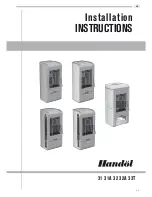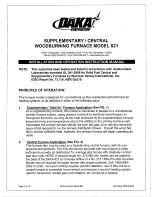
20
• The chimney has been swept and tested prior to
installation.
• The proximity of all combustible materials to the
intended stove installation conforms to the minimum
requirements outlined within this handbook as well
as local, national and European building regulations,
whichever is the greater. A combustible material is
anything which can burn once it gets hot enough
and includes skirting boards, wooden fire surrounds,
wooden mantles, wallpaper, fabrics and floor
coverings. Remember these materials could be
concealed behind other materials which on the
surface may appear to be non-combustible, for
example, stud partitioned walls. It also worth noting
that some heat-resistant materials could eventually
combust should they inadvertently reach the required
higher combustion temperatures.
Important Minimum Distances For This Stove
The minimum distances to combustible materials for
the GR910-B Graphite Boiler are as follows:
Sides
100mm (4”)
Rear
200mm (8”)
We do not recommend the use of a combustible
mantel (eg wood) above this stove.
In a traditional brick or stone built fireplace the
recommended minimum safe operating distances at
the sides of the stove are 150mm (6”), 75mm (3”) at
the rear and 300mm (12”) above the stove.
APPLIANCE INSTALLATION:
GENERAL GUIDELINES
Please refer specifically to current building regulations
which apply to your country or region. Adopt
whichever provides the highest / safest margin.
Asbestos
This stove does not contain Asbestos. However, check
that there is no possibility of disturbing any asbestos-
based materials during its installation. You may
intend removing an older appliance prior to installing
your new stove, and you should be aware that the
old appliance or installation could incorporate heat
protective asbestos sheet or other asbestos-based
materials – if in doubt seek guidance at
www.hse.
gov.uk/asbestos
– do not underestimate the potential
health hazards of handling Asbestos.
Fire Cement
Always read the Fire Cement manufacturer’s
instructions first. Prolonged contact with fire cement
and skin should be avoided. Protective gloves and
glasses should be worn when applying fire cement.
Care should also be taken to avoid unnecessary
contact between the stove’s surfaces and the fire
cement as this could damage the paintwork. Any
excess fire cement should be quickly removed before
it hardens.
The Hearth and ‘Fireplace’
• The hearth should be made of solid non-
combustible material, set on a firm and level base and
should be at least 125mm (5”) thick. This can include
the thickness of any non-combustible floor under
the hearth or non-combustible decorative surface.
It must be capable of supporting the weight of the
stove(when loaded) and boiler (with water add
approx 15kg) along with any attached flexible flue
liner which may bear down on the stove. This hearth
must conform to local building regulations which may
vary from country to country.
• In England and Wales there is a minimum
requirement for the hearth to project 500mm (20”) in
front of any brick or stone recess and 150mm (6”) at
each side of the recess. The hearth should extend by a
minimum of 225mm (9”) from the front of the stove
(which includes the edge of the ash lip). As a general
rule we recommend extending the hearth to at least
75mm (3”) beyond the furthest out-swing of the
stove door if possible to avoid any potential live ash
held on the stove door falling on to combustible
flooring or floor coverings. If the top of the hearth
and any combustible floor coverings are level with
each other then a retaining fender should be fitted to
warn occupants of the hearth area. Alternatively,
a 28mm (1.1”) change in level provided by a
decorative non-combustible material such as stone,
marble, granite, ceramic tiles etc could be used.
• If using a fire surround it should be made of non-
combustible materials as well as be suitable for use
with a solid fuel stove. For example the hearth and
mantlepiece ideally should be ‘slabbed’ with concrete
and any decorative surface finishes, such as marble,
should be ‘tiled’ to allow for heat expansion. Some
materials may not be suitable when used in a single
sheet. This may prove problematic if, for example, the
stove is being installed within an existing fire surround
where the back panel has been removed to create a
larger opening in the chimney breast. If a potentially
combustible fire surround is being used then
adherence to the ‘distance to combustible materials’
indicated on page 5 should be strictly observed. Your
stove dealer or installer should be able to advise you
about the suitability of an existing fire surround.
• The fireplace side and rear walls should be at least
75mm thick and made of non-combustible brick or
stone.
Flue Draught
The Graphite Boiler has been tested with a flue
draught pressure of 12pa and therefore to ensure
performance which is line with the test results on
page 5 the ideal flue draught pressure should be
approximately 12Pa.
The Chimney, Flue and Flexible Liners
• Other flued appliances must not share or be
connected to the same flue system or chimney as this
boiler stove.
•
Generally speaking, the chimney or flue terminal
must be above the height of the apex of the build-
Содержание GR910-B
Страница 4: ...4 GENERAL DIMENSIONS ...
Страница 22: ... 23 ...
















































